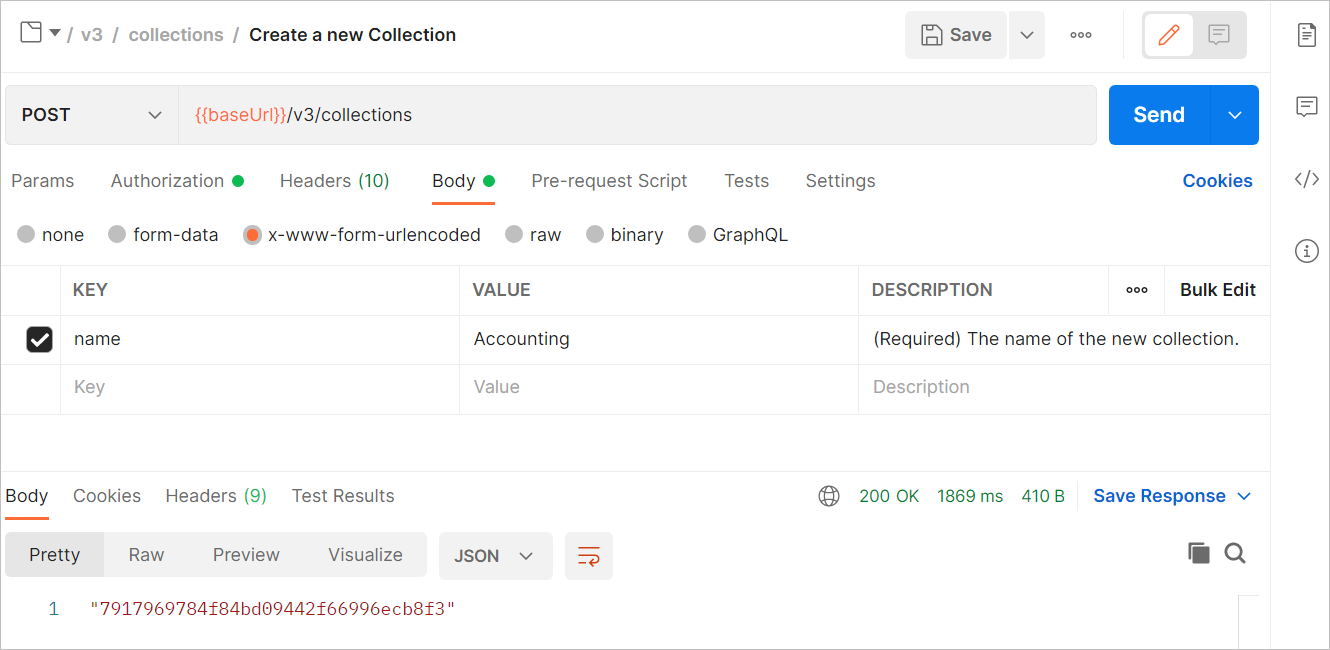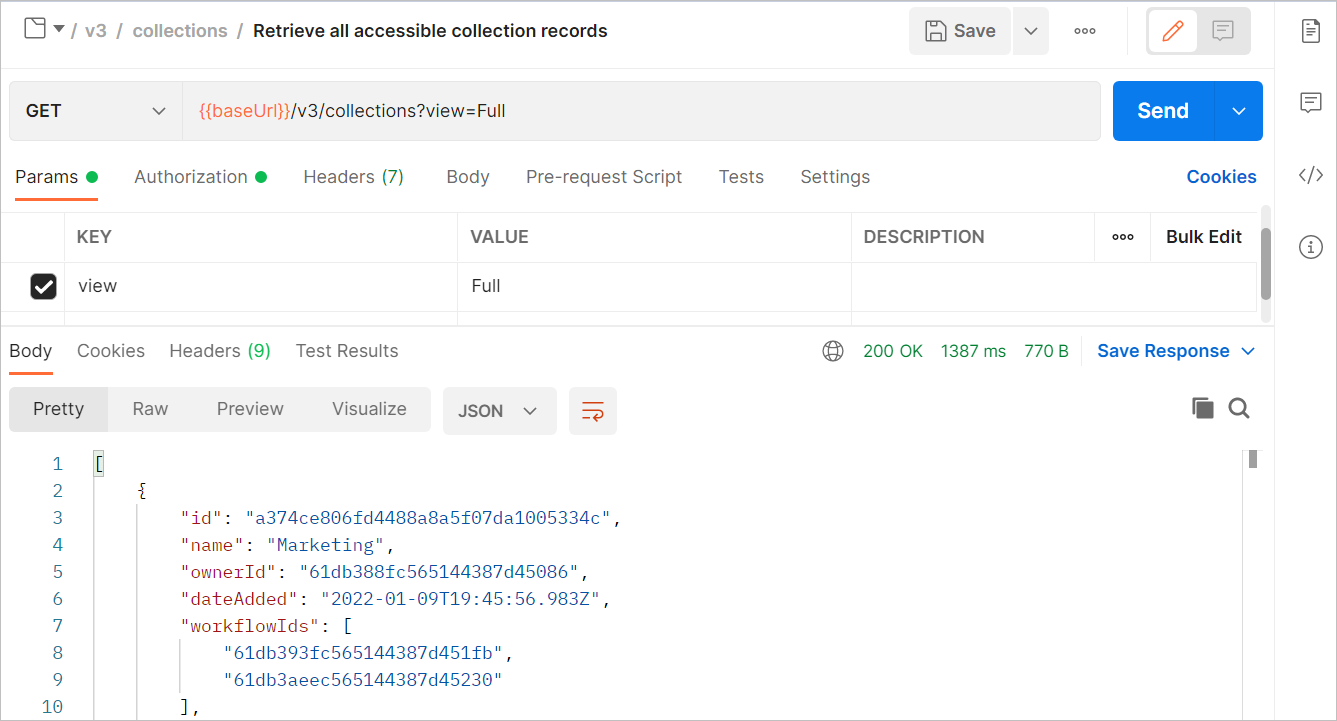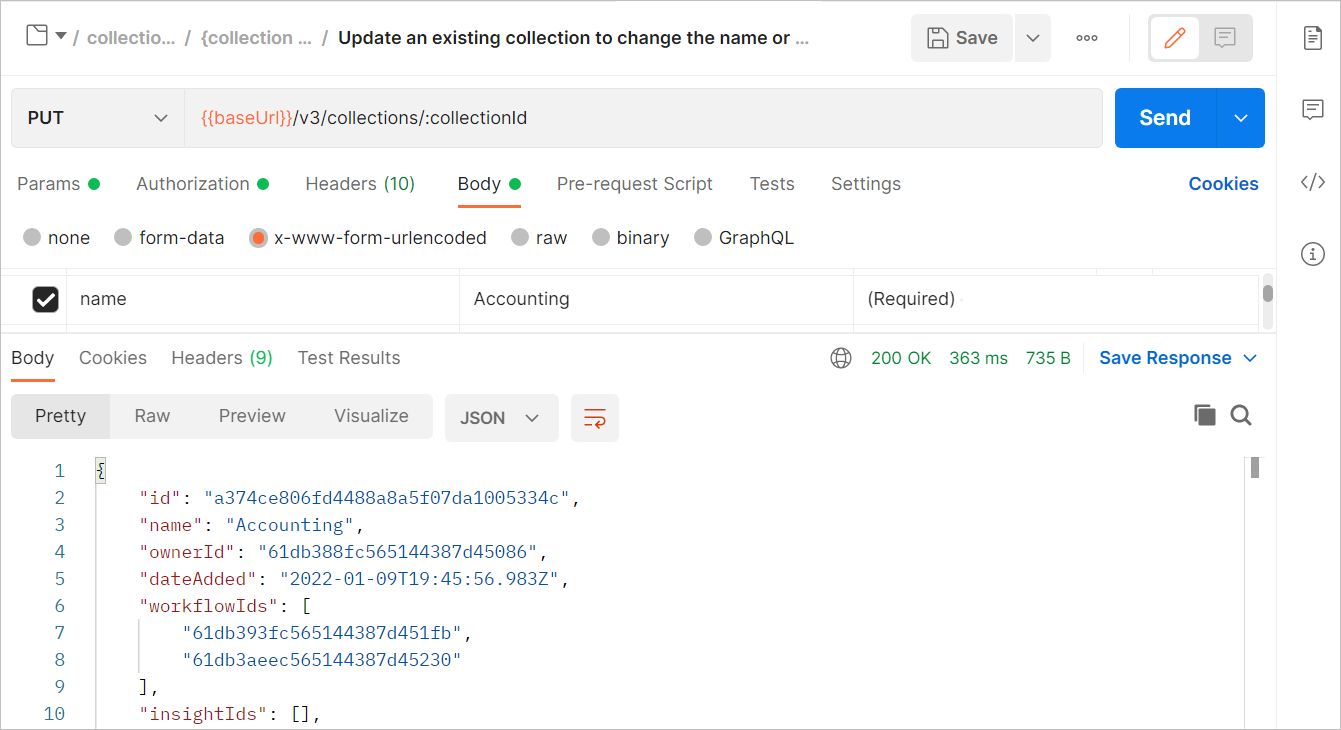Add an Insight to a Collection
Add a Schedule to a Collection
Add a Workflow to a Collection
Add a User Group to a Collection
Retrieve Records of All Collections
Update User Permissions of a Collection
Update User Group Permissions of a Collection
Remove a User from a Collection
Remove a Workflow from a Collection
Remove an Insight from a Collection
Remove a Schedule from a Collection
Remove a User Group from a Collection
To learn more about the objects relations and how to use them in the API, go to the Object Relations section.
For more information about collections, visit the Collections help page.
To create a collection, use the POST {baseURL}/v3/collections endpoint.
contract (body): To create a collection, the contract parameter is required. Specify the following to create a collection:
name (string): Required. Specify a collection name.
curl --location --request POST 'http://localhost/webapi//v3/collections' \ --header 'Content-Type: application/x-www-form-urlencoded' \ --header 'Authorization: Bearer BearerTokenGoesHere' \ --data-urlencode 'name=Accounting'
To add a user to a collection, use the POST {baseURL}/v3/collections/{collectionId}/users endpoint.

collectionId (string): Required. Enter a collection ID to specify the collection to add a user to.
addUsersContract (body): Required. Enter an information about the users and their permissions. Specify the following to add users to a collection:
userId (string): Required. Specify the ID of a user you want to add to a collection.
expirationDate (string): Optional. Specify the expiration date for the user to be part of this collection. Enter the date and time in ISO8601 format.
collectionsPermissions (body):
isAdmin (boolean): Required. Specify whether the user should be admin for this collection.
canAddAssets (boolean): Required. Specify whether the user can add assets to the collection.
canUpdateAssets (boolean): Required. Specify whether the user can update assets in the collection.
canRemoveAssets (boolean): Required. Specify whether the user can remove assets from the collection.
canAddUsers (boolean): Optional. Specify whether the user can add other users to the collection.
canRemoveUsers (boolean): Optional. Specify whether the user can remove users from the collection.
For more information about roles and permissions, visit the User Roles and Permissions page. When no role is selected, the default is the default role as specified by a Server administrator in the Admin interface.
curl --location --request POST 'http://localhost/webapi//v3/collections/7917969784f84bd09442f66996ecb8f3/users' \ --header 'Content-Type: application/x-www-form-urlencoded' \ --header 'Authorization: Bearer BearerTokenGoesHere' \ --data-urlencode 'userId=61d80f862835728c94328082' \ --data-urlencode 'isAdmin=true' \ --data-urlencode 'canAddAssets=true' \ --data-urlencode 'canRemoveAssets=true' \ --data-urlencode 'canUpdateAssets=true' \ --data-urlencode 'canAddUsers=true' \ --data-urlencode 'canRemoveUsers=true' \ --data-urlencode 'expirationDate=2007-08-17T19:18:11.924Z'
Back to Collection Endpoints overview.
To add an insight to a collection, use the POST {baseURL}/v3/collections/{collectionId}/insights endpoint.
collectionId (string): Required. Enter a collection ID to specify the collection to add an insight to.
contract (body): Required. Enter an information about the insight. Specify the following:
insightId (string): Required. Specify the insight ID you want to add to the collection.
curl --location --request POST 'http://localhost/webapi//v3/collections/472dfff22086458d935d4edf348a1e2b/insights' \ --header 'Content-Type: application/x-www-form-urlencoded' \ --header 'Authorization: Bearer BearerTokenGoesHere' \ --data-urlencode 'insightId=61d80f33452835728c94328082'
Back to Collection Endpoints overview.
To add a schedule to a collection, use the POST {baseURL}/v3/collections/{collectionId}/schedules endpoint.
collectionId (string): Required. Enter a collection ID to specify the collection to add a schedule to.
contract (body): Required. Enter an information about the schedule. Specify the following:
scheduleId (string): Required. Specify the schedule ID you want to add to the collection.
curl --location --request POST 'http://localhost/webapi//v3/collections/7917969784f84bd09442f66996ecb8f3/schedules' \ --header 'Content-Type: application/x-www-form-urlencoded' \ --header 'Authorization: Bearer BearerTokenGoesHere' \ --data-urlencode 'scheduleId=61d80f334528377728c94328082'
Back to Collection Endpoints overview.
To add a workflow to a collection, use the POST {baseURL}/v3/collections/{collectionId}/workflows endpoint.
collectionId (string): Required. Enter a collection ID to specify the collection to add an insight to.
contract (body): Required. Enter an information about the users and their permissions. Specify the following:
workflowId (string): Required. Specify the workflow ID you want to add to the collection.
curl --location --request POST 'http://localhost/webapi//v3/collections/7917969784f84bd09442f66996ecb8f3/workflows' \ --header 'Content-Type: application/x-www-form-urlencoded' \ --header 'Authorization: Bearer BearerTokenGoesHere' \ --data-urlencode 'workflowId=61d80f334223377728c9432'
Back to Collection Endpoints overview.
To add a user group to a collection, use the POST {baseURL}/v3/collections/{collectionId}/userGroups endpoint.
collectionId (string): Required. Enter a collection ID to specify the collection to add a user group to.
addUserGroupsContract (body): Required. Enter an information about the user group and its permissions. Specify the following:
userGroupId (string): Required. Specify the ID of a user group you want to add to a collection.
expirationDate (string): Optional. Specify the expiration date for the user group to be part of this collection. Enter the date and time after which the user was created in ISO8601 format.
collectionsPermissions (body): Required.
isAdmin (boolean): Optional. Specify whether the user group members should be admins for this collection. Default is false.
canAddAssets (boolean): Optional. Specify whether the user group members can add assets to the collection. Default is false.
canRemoveAssets (boolean): Optional. Specify whether the user group members can remove assets from the collection. Default is false.
canUpdateAssets (boolean): Optional. Specify whether the user group members can update assets in the collection. Default is false.
canAddUsers (boolean): Optional. Specify whether the user group members can add other users to the collection. Default is false.
canRemoveUsers (boolean): Required. Specify whether the user group members can remove other users from the collection. Default is false.
For more information about roles and permissions, visit the User Roles and Permissions page. When no role is selected, the default is the default role as specified by a Server administrator in the Admin interface.
curl --location --request POST 'http://localhost/webapi//v3/collections/7917969784f84bd09442f66996ecb8f3/userGroups?addUserGroupsContract' \ --header 'Content-Type: application/x-www-form-urlencoded' \ --header 'Authorization: Bearer BearerTokenGoesHere' \ --data-urlencode 'userGroupId=61d83e2ef778247f14e8e6b6' \ --data-urlencode 'isAdmin=true' \ --data-urlencode 'canAddAssets=false' \ --data-urlencode 'canRemoveAssets=true' \ --data-urlencode 'canUpdateAssets=false' \ --data-urlencode 'canAddUsers=true' \ --data-urlencode 'canRemoveUsers=true'
Back to Collection Endpoints overview.
To retrieve information about a collection, use the GET {baseURL}/v3/collections/{collectionId} endpoint.
collectionId (string): Required. Enter a collection ID to get the information about the collection.
curl --location --request GET 'http://localhost/webapi/v3/collections/a374ce806fd4488a8a5f07da1005334c' \ --header 'Authorization: Bearer BearerTokenGoesHere'
Back to Collection Endpoints overview.
To retrieve all accessible collection records, use the GET {baseURL}/v3/collections endpoint.
view (string): Optional. Can be left without a value. You can choose from the following values: ‘Default’ and ‘Full’. If this parameter is set to 'Default’, then a reduced view object will be returned. When not specified, the ‘Default’ value is used.
curl --location --request GET 'http://localhost/webapi/v3/collections?view=Full' \ --header 'Authorization: Bearer BearerTokenGoesHere'
Back to Collection Endpoints overview.
To change the name or owner of a collection, use the PUT {baseURL}/v3/collections/{collectionId} endpoint.
collectionId (string): Required. Enter a collection ID to specify the collection you want to update.
updateCollectionContract (body): Required. Enter information about the collection owner you want to change. Specify the following:
name (string): Required. Enter the new name of the collection.
ownerId (string): Required. Enter the ID of the new owner.
curl --location --request PUT 'http://localhost/webapi/v3/collections/a374ce806fd4488a8a5f07da1005334c' \ --header 'Content-Type: application/x-www-form-urlencoded' \ --header 'Authorization: Bearer BearerTokenGoesHere' \ --data-urlencode 'name=Accounting' \ --data-urlencode 'ownerId=61db388fc565144387d45086'
Back to Collection Endpoints overview.
To update user permissions for a certain collection, use the PUT {baseURL}/v3/collections/{collectionId}/users/{userId}/permissions endpoint.
collectionId (string): Required. Enter a collection ID to specify the collection you want to update.
userId (string): Required. Enter a user ID you want to change the permissions for.
updatePermissionsContract (body): Required. Enter the user ID for which you want to change permissions. Specify the following:
expirationDate (date): Required. Specify the expiration date of a user.
collectionsPermissions (body): Required. Enter the user ID of the new owner. Specify the following:
isAdmin (boolean): Required. Specify whether the user should be admin for this collection.
canAddAssets (boolean): Required. Specify whether the user can add assets to the collection.
canRemoveAssets (boolean): Required. Specify whether the user can remove assets from the collection.
canUpdateAssets (boolean): Required. Specify whether the user can update assets in the collection.
canAddUsers (boolean): Required. Specify whether the user can add other users to the collection.
canRemoveUsers (boolean): Required. Specify whether the user can remove other users from the collection.
For more information about roles and permissions, visit the User Roles and Permissions page. When no role is selected, the default is the default role as specified by a Server administrator in the Admin interface.
curl --location --request PUT 'http://localhost/webapi/v3/collections/a374ce806fd4488a8a5f07da1005334c/users/61db388fc565144387d45086/permissions' \ --header 'Content-Type: application/x-www-form-urlencoded' \ --header 'Authorization: Bearer BearerTokenGoesHere' \ --data-urlencode 'isAdmin=true' \ --data-urlencode 'canAddAssets=true' \ --data-urlencode 'canRemoveAssets=true' \ --data-urlencode 'canUpdateAssets=true' \ --data-urlencode 'canAddUsers=true' \ --data-urlencode 'canRemoveUsers=true'
Back to Collection Endpoints overview.
To update user group permissions for a certain collection, use the PUT {baseURL}/v3/collections/{collectionId}/userGroups/{userGroupId}/permissions endpoint.
collectionId (string): Required. Enter a collection ID to specify the collection you want to update.
userGroupId (string): Required. Enter a user group ID you want to change the permissions for.
updatePermissionsContract (body): Required. Enter the user group ID for which you want to change permissions. Specify the following:
expirationDate (date): Optional. Specify the expiration date for a user group.
collectionsPermissions (body): Required. Specify the following:
isAdmin (boolean): Required. Specify whether the user group members should be admin for this collection.
canAddAssets (boolean): Required. Specify whether the user group members can add assets to the collection.
canRemoveAssets (boolean): Required. Specify whether the user group members can remove assets from the collection.
canUpdateAssets (boolean): Required. Specify whether the user group members can update assets in the collection.
canAddUsers (boolean): Required. Specify whether the user group members can add other users to the collection.
canRemoveUsers (boolean): Required. Specify whether the user group members can remove users to the collection.
For more information about roles and permissions, visit the User Roles and Permissions page. When no role is selected, the default is the default role as specified by a Server administrator in the Admin interface.
curl --location --request PUT 'http://localhost/webapi/v3/collections/a374ce806fd4488a8a5f07da1005334c/userGroups/61db38834tssrdrs4cc65144387d4508/permissions' \ --header 'Content-Type: application/x-www-form-urlencoded' \ --header 'Authorization: Bearer BearerTokenGoesHere' \ --data-urlencode 'isAdmin=true' \ --data-urlencode 'canAddAssets=true' \ --data-urlencode 'canRemoveAssets=false' \ --data-urlencode 'canUpdateAssets=true' \ --data-urlencode 'canAddUsers=true' \ --data-urlencode 'canRemoveUsers=true'
Back to Collection Endpoints overview.
To remove a user from a collection, use the DELETE {baseURL}/v3/collections/{collectionId}/users/{userId} endpoint.
collectionId (string): Required. Enter a collection ID to specify the collection you want to update.
userId (string): Required. Enter a user ID you want to remove from the collection.
curl --location --request DELETE 'http://localhost/webapi/v3/collections/a374ce806fd4488a8a5f07da1005334c/users/61db388fc565144387d45086' \ --header 'Authorization: Bearer BearerTokenGoesHere'
Back to Collection Endpoints overview.
To remove a workflow from a collection, use the DELETE {baseURL}/v3/collections/{collectionId}/workflows/{appId} endpoint.
collectionId (string): Required. Enter a collection ID to specify the collection you want to update.
appId (string): Required. Enter a workflow ID you want to remove from the collection.
curl --location --request DELETE 'http://localhost/webapi/v3/collections/a374ce806fd4488a8a5f07da1005334c/workflows/61db388fc565144387d45086' \ --header 'Authorization: Bearer BearerTokenGoesHere'
Back to Collection Endpoints overview.
To remove an insight from a collection, use the DELETE {baseURL}/v3/collections/{collectionId}/insights/{insightId} endpoint.
collectionId (string): Required. Enter a collection ID to specify the collection you want to update.
insightId (string): Required. Enter an insight ID you want to remove from the collection.
curl --location --request DELETE 'http://localhost/webapi/v3/collections/a374ce806fd4488a8a5f07da1005334c/insights/61db388fc565144387d450867' \ --header 'Authorization: Bearer BearerTokenGoesHere'
Back to Collection Endpoints overview.
To remove a schedule from a collection, use the DELETE {baseURL}/v3/collections/{collectionId}/schedules/{scheduleId} endpoint.
collectionId (string): Required. Enter a collection ID to specify the collection you want to update.
scheduleId (string): Required. Enter a schedule ID you want to remove from the collection.
curl --location --request DELETE 'http://localhost/webapi/v3/collections/a374ce806fd4488a8a5f07da1005334c/schedules/61db3777c565144387d450867' \ --header 'Authorization: Bearer BearerTokenGoesHere'
Back to Collection Endpoints overview.
To remove a user group from a collection, use the DELETE {baseURL}/v3/collections/{collectionId}/userGroups/{userGroupId} endpoint.
collectionId (string): Required. Enter a collection ID to specify the collection you want to update.
userGroupId (string): Required. Enter a user group ID you want to remove from the collection.
curl --location --request DELETE 'http://localhost/webapi/v3/collections/a374ce806fd4488a8a5f07da1005334c/userGroups/61dc063d9938fe43b5e8fc80' \ --header 'Authorization: Bearer BearerTokenGoesHere'
Back to Collection Endpoints overview.
To delete a collection, use the DELETE {baseURL}/v3/collections/{collectionId} endpoint.
collectionId (string): Required. Enter a collection ID to specify the collection you want to update.
forceDelete (boolean): Optional. Select whether you want to force the deletion of a collection in case this collection has links to other objects, such as users, groups, workflows, insights and schedules. If you want the collection deleted and all links cleaned up, set the forceDelete parameter to true. When not selected, the default value is false. This parameter is used in order to protect against an errant call.
curl --location --request DELETE 'http://localhost/webapi/v3/collections/253fcf0b10204dc085f07bdf1b40e759?forceDelete=true' \ --header 'Authorization: Bearer BearerTokenGoesHere'
Back to Collection Endpoints overview.
If you are creating a collection, you can use created objects as follows:
Object created: "id" (for example, "id": "7917969784f84bd09442f66996ecb8f3")
You can use it as:
collectionId if you are searching for a specific collection.
collectionId if you are adding users, user groups, workflows, insights, or schedules to a collection.
collectionId if you are updating an existing collection.
collectionId if you want to delete a specific collection.
POST /v3/collections

GET /v3/collections/

PUT /v3/collections/{collectionId}

To know more about Postman requests, visit the How to Use Postman help page.